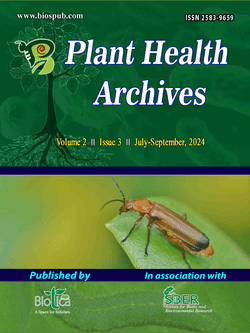
Influence of Spacing and Nutrient Management on Growth and Yield of Tree Mulberry Genotypes
Devamani M.*
Division of Moriculture, Karnataka State Sericulture Research and Development Institute, Thalghattapura, Bangalore, Karnataka (560 109), India
Thimma Reddy H.
Division of Moriculture, Karnataka State Sericulture Research and Development Institute, Thalghattapura, Bangalore, Karnataka (560 109), India
DOI: https://doi.org/10.54083/PHA/2.3.2024/89-97
Keywords: Chemical fertilizers, FYM, Green manures, V1, Vishala
Abstract
The KSSRDI conducted research from 2018 to 2021 in Bengaluru, assessing tree mulberry growth, yield and moisture with 8′×8′ and 10′×10′ spacings and four nutrient levels. Data from eight crop cycles were collected and analysis used a three-factor split-split-plot design via OPSTAT. The study compared V1 and Vishala mulberry genotypes, highlighting Vishala's superior growth and yield. Vishala had more branches tree-1 (35.50), longer branches (143.23 cm), more leaves branch-1 (31.69), higher leaf and stem yield (27.18 and 18.42 mt ha-1yr-1). V1 exhibited higher leaf stem-1 moisture (74.69% and 71.77%) compared to Vishala (69.76% and 67.26%). Among specific combinations, S1N4 and S1N3 yielded the highest leaf stem-1 output (29.90 and 19.70 mt ha-1yr-1), while S2N4 and S2N3 had more branches tree-1 and longer branches. This study highlights Vishala′s potential for increased productivity and sheds light on nutrient levels and spacing effects on mulberry growth and yield. Interactions between factors did not significantly affect mulberry growth and yield parameters. The study recommends an 8'×8' spacing with 75% of the recommended fertilizer dose (105:42:42 kg NPK acre-1year-1), alongside the application of 10 tons acre-1year-1 of Farm Yard Manure, biofertilizers Prakruthi and Seri-Phos, and green manure crops like Sunhemp and Cowpea.
Downloads
not found
Reference
Bongale, U.D., 2000. Productivity alleviation in mulberry cultivation - An appraisal. Lead paper. In: National Conference on Strategies for Sericulture Research and Development. 16th-18th November, 2000, Mysore. Central Sericulture Research and Training Institute, Mysore, India. pp. 34-37.
Das, P.C., Choudhury, P.C., Ghosh, A., Katiyar, R.S., Mathur, U.B., Datta, R.K., 1993. Use of Azotobacter biofertilizer in mulberry cultivation. Indian Silk 31(10), 43-45.
Devamani, M., Dahira Beevi, N., Mohan, A., 2024. Influence of macro- and micro-fertilizers on silkworm economic parameters. Plant Health Archives 2(2), 41-47. DOI: https://doi.org/10.54083/PHA/2.2.2024/41-47.
Du, Z.H., Liu, J.F., Liu, G., 2001. Study on mulberry trees as both water and soil conservation and economy trees. Journal of Guangxi Sericulture 38(2), 10-12.
Eltayb, M.T.A., Warrag, E.E.I., Ahamed, A.E., 2013. Effect of spacing on performance of Morus species. Journal of Forest Products and Industries 2(3), 13-23.
Fotedar, R.K., Dhar, S., Mukherjee, P., 1995. Effect of different pruning height on the mulberry yield and silkworm rearing. Indian Journal of Sericulture 24(2), 105-109.
Jackson, M.L., 1973. Soil Chemical Analysis, 1st Edition. Prentice Hall of India Private Limited, New Delhi, India. p. 498.
John, M.K., Chuah, H.H., Neufeld, J.H., 1975. Application of improved Azomethine-H method to determination of boron in soils and plants. Analytical Letters 8(8), 559-568. DOI: https://doi.org/10.1080/00032717508058240.
Kjeldahl, J.A., 1883. New method for the estimation of nitrogen in organic compounds. Journal of Analytical Chemistry 22, 366-382. DOI: https://doi.org/10.1007/BF01338151.
Lindsay, W.L., Norvel, W.A., 1978. Development of DTPA soil test for Zn, Fe, Mn and Cu. Soil Science Society of America Journal 42(3), 421-428. DOI: https://doi.org/10.2136/sssaj1978.03615995004200030009x.
Magadum, S.K., Aziz, F., Lal, J., Bala, M., Sharma, P., Sharma, A., Kouser, R., Deskit, L., Singh, S., 2019. Evaluation of effect of different mulberry plantation systems on rearing performance of silkworm (Bombyx mori L.). International Journal of Agriculture Sciences 11(24), 9354-9357.
Magadum, S.K., Sharma, P., Bala, M., Kouser, R., Sharma, A., Deskit, L., Aziz, F., Lal, J., Singh, S., 2020. Evaluation of different mulberry plantation systems for leaf yield and yield contributing characters. International Journal of Current Microbiology and Applied Sciences 9(12), 3222-3229. DOI: https://doi.org/10.20546/ijcmas.2020.912.383.
Murthy, V.N.Y., Ramesh, H.L., Munirajappa, 2013. Evaluation of mulberry (Morus) variety Vishwa for leaf yielding parameters and phytochemical analysis under different spacing systems. Indian Journal of Applied Research 3(8), 31-33.
Nambiar, K.K.M., Abrol, I.P., 1992. Long term fertilizer experiments in India - An overview. Fertilizer News 34(4), 11-26.
Olsen, S.R., Cole, C.V., Watanabe, F.S., 1954. Estimation of available phosphorus in soils by extraction with sodium bicarbonate. USDA Circular No. 939, US Government Printing Office, Washington DC. pp. 1-19.
Qader, M.A., 1991. Varietal differences and correlation studies in the nutritional composition of the mulberry. Sericologia 31(3), 449-453.
Shi, D.M., 2005. Study on functions of soil and water conservation by mulberry hedgerow intercropping of purple soil slopping farmland in three gorges reservoir region. Journal of Soil and Water Conservation 19(3), 75-79.
Shivaprakash, R.M., Bongale, U.D., Dandin, S.B., Basavaiah, Siddalingaswamy, N., Narayana Gowda, S.N., 2000. Nitrogen uptake and shoot yield in three improved variety of mulberry (Morus indica L.) under irrigated field condition. Indian Journal of Sericulture 39(2), 145-148.
Singh, N., Tara, J.S., Rajput, S., Chanotra, S., Gupta, R., Bashir, M., Dar, I.A., Dhar, N., Mohan, R., 2016. Studies on the mode of plantation of mulberry for silkworm rearing. International Journal of Advanced Research 4(6), 1420-1423. DOI: https://doi.org/10.21474/IJAR01.
Sudhakar, P., Hanumantharayappa, S.K., Sudhakar Rao, P., Kumar, J.S., Sivaprasad, V., 2018. Tree mulberry sustainable and economically viable sericultural farming for Southern tropical zones. International Journal of Applied and Pure Science and Agriculture 4(6), 13-23.
Sudhakar, P., Kiran Kumar, K.P., Vijaya Naidu, B., Babulal, 2021. Tree mulberry: The future of tropical sericulture farming. Biotica Research Today 3(5), 297-302.
Walkley, A., Black, I.A., 1934. An examination of the Degtjareff method for determining soil organic matter and a proposed modification of chromic acid titration method. Soil Science 37(1), 29-38. DOI: https://doi.org/10.1097/00010694-193401000-00003.
Yadav, V.K., Morrison, M.N., Arunakumar, G.S., Padhan, P., Praveen Kumar, K., Sivaprasad, V., Tewary, P., 2020. Comparative study on different mulberry spacing and its impact on mulberry leaf yield and silkworm rearing. Journal of Entomology and Zoology Studies 8(1), 1110-1115.
